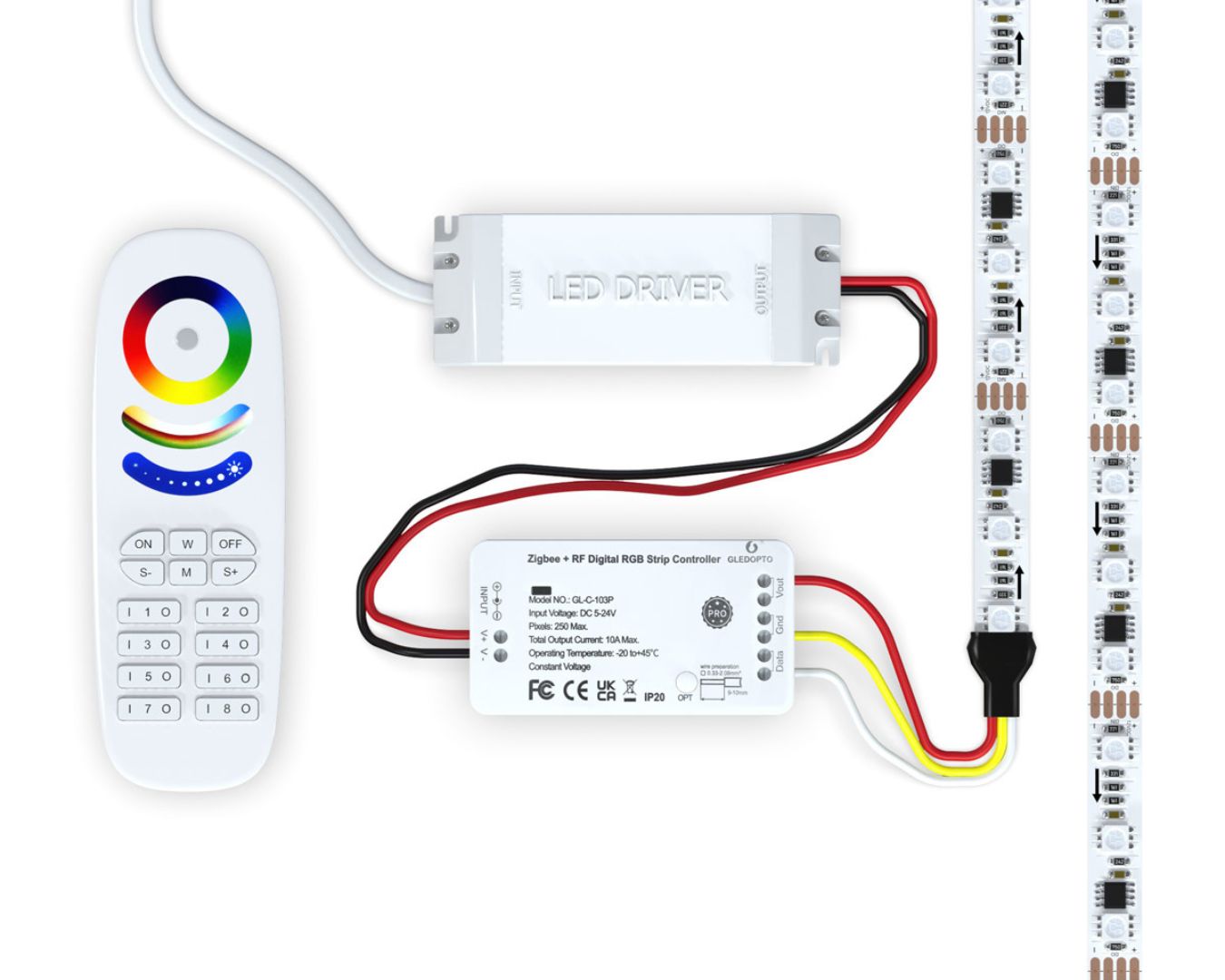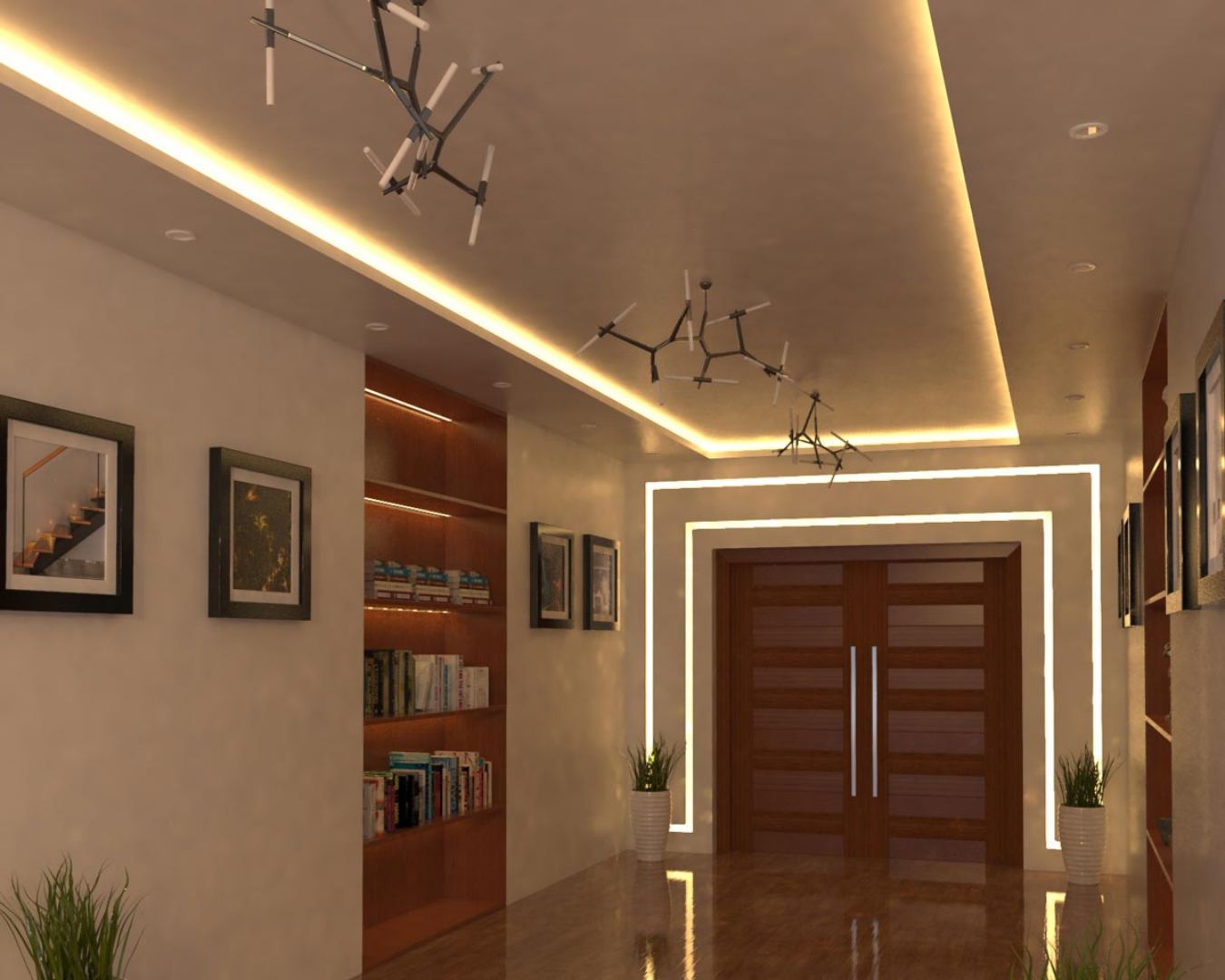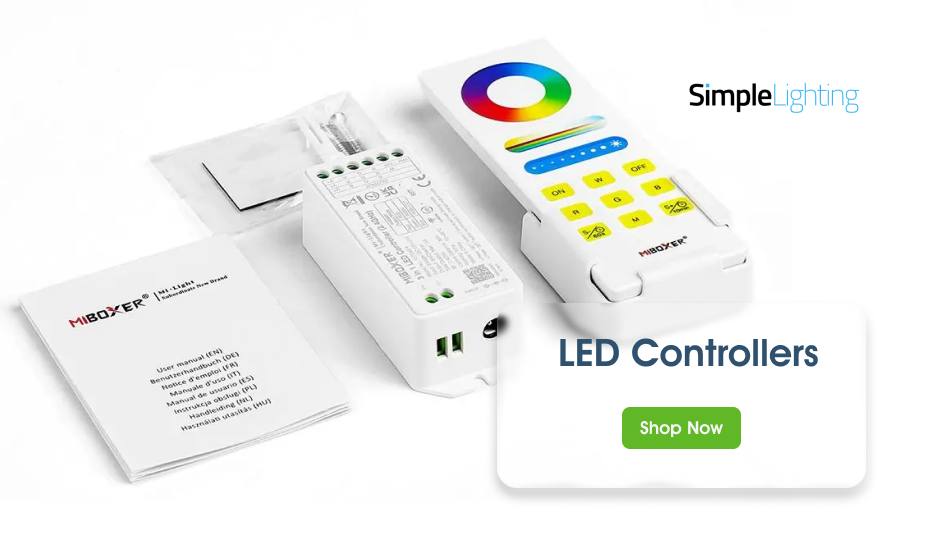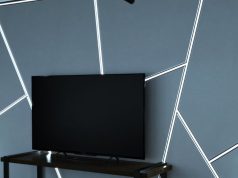No one is a stranger to LED strip lighting anymore.
You see them glowing in kitchens as plinths and under-cabinet lights, in the living room as bias lighting for the TV, or in the hallway pulsing behind the ceiling cove.
They’re simple to set up and even simpler to use.
And there are two crucial components that make your LED strips safe, reliable, and exceptionally functional.
They’re the controller and the LED driver. They’re behind every perfect glow and dynamic colour effect of all the LED strip lights you see.
In this guide, we’ll uncover everything there is that you need to know about these two: what they do, how they work, and how to choose the right ones for your lighting project.
Grab a cuppa, because we’re diving in.
What is an LED Strip Driver?
An LED strip driver (also known as a power supply) is the heart of any LED lighting system.
Its job is simple yet critical.
As you know (or might not, but anyway), LED strip lights are low-voltage lights. Unlike your typical home lights that run on 220-240V, LED strips usually run on 12V or 24V.
So, a driver’s job is to convert your home’s high-voltage AC power (typically 230V in the UK) into the low-voltage DC power (that’s the 12V or 24V) that LED strips need to operate safely.
Pretty simple to understand, right?
Power Conversion and Current Regulation
Converting high-voltage electricity (AC) to low-voltage DC is not the only thing an LED driver does. It also regulates both voltage and current, preventing fluctuations that could damage the LEDs.
So, in essence, the driver does three things simultaneously:
- Converts AC mains electricity into a low-voltage DC output.
- Regulates current to prevent overloading or overheating.
- Protects the LEDs from power surges or inconsistent voltage.
Without the correct driver, your LED strip might flicker, dim unevenly, or even fail prematurely.
Why the Right Driver Matters
The previous sentence pretty much already summarises this, but for a more detailed take, using the correct driver ensures:
- Longer LED lifespan by keeping power stable and within limits.
- Improved safety by isolating low-voltage circuits from high-voltage mains.
- Consistent brightness — meaning no flicker, dimming issues, or uneven illumination.
Think of the driver like a translator between your mains power and your LED strip, ensuring smooth communication and reliable performance.
What is an LED Strip Controller?
While drivers handle the power, controllers handle the personality.
Whose personality? Yours, of course.
An LED strip controller lets you change colours, brightness, and lighting effects, turning static lighting into a dynamic design feature.
In other words, controllers let you inject your personality into your lighting.
For single-colour LED strips, a controller might simply adjust brightness.
For RGB or RGBW strips, it offers additional features, such as cycling through millions of hues, fading smoothly between scenes, or syncing to music or smart home systems.
How Controllers Work with Drivers and LED Strips
A typical setup looks like this:
Mains Power (230V AC) → LED Driver (12V/24V DC) → LED Controller → LED Strip
- The driver provides the correct voltage.
- The controller sends commands (such as “dim to 50%” or “change to blue”) to the LED strip.
Together, the driver and controller create a safe and manageable lighting system.
Types of Controllers
There are various controller types depending on your needs and how you want to interact with your lights:
- IR (Infrared): Operated via a handheld remote. Simple and affordable.
- RF (Radio Frequency): Works even without a line of sight from the light, ideal for concealed installations.
- Wi-Fi / Bluetooth: Connects to mobile apps for wireless control.
- DMX / DALI: Used in professional or commercial lighting systems for precise control.
For home installations, the Wi-Fi/Bluetooth option is more commonly used.
Types of LED Strip Drivers
Not all LED strips require the same type of driver.
Choosing the right one depends on how your LEDs are designed to handle current.
Ask your manufacturer or check the labels to figure out which driver you need.
Constant Voltage (CV) Drivers
Constant voltage drivers are the most common for LED strip lighting.
They maintain a steady voltage output (typically 12V or 24V), while the LED strip itself regulates current through built-in resistors or internal circuitry.
Best for:
Standard LED strips marked as 12V or 24V, such as most single-colour, RGB, or RGBW strips.
Example use case:
If you have a five-metre, 24V LED strip under your kitchen cabinets, you’ll use a 24V constant voltage driver rated slightly higher than your strip’s total wattage (10-20% safety margin).
Constant Current (CC) Drivers
Constant current drivers, on the other hand, supply a fixed current (e.g., 350mA, 700mA) and vary the voltage as needed.
They’re used for high-power LEDs or specialised strips that don’t have built-in resistors.
In other words, they’re not commonly used for home lighting.
Best for:
Architectural or commercial lighting where precise current regulation is needed.
Example use case:
A bespoke wall feature using high-intensity LED modules requiring 700mA of constant current.
Types of LED Strip Controllers
The type of controller you need depends on your LED strip type and the kind of control you want.
Controls can vary from simple on/off switches to smart home integration.
Single-Colour Controllers
These controllers handle basic dimming and switching for, you guessed it, single-colour LED strips.
You can turn the lights on or off or adjust their brightness levels, using a remote or a wall-mounted dimmer.
Perfect for: Under-cabinet task lighting, display shelves, or accent lighting where colour changing isn’t needed.
RGB Controllers
RGB controllers manage red, green, and blue (RGB) channels to create millions of colour combinations. You can set static colours, create fades, or run dynamic effects.
Perfect for: Decorative features like coves, bars, or living room backlighting. Also great for colour-changing accent lights.
RGBW and Tunable White Controllers
These controllers are a little more “advanced” and can add either:
- A white channel (RGBW) for more accurate whites and pastels, or
- Tunable white control, allowing you to adjust the colour temperature of your lights from warm (2700K) to cool (6500K) and anything in between.
Perfect for: Spaces that need both ambience and functional lighting, like bedrooms, restaurants, or offices.
Smart Controllers
Smart LED controllers connect via Wi-Fi, Bluetooth, or Zigbee, allowing app-based control, voice commands, and smart home integration (with Alexa, Google Home, and other smart home systems).
Why go smart?
- Set schedules and scenes.
- Sync lights to music or gameplay (for gaming setups).
- Adjust lighting remotely through apps.
Perfect for: Modern homes and users seeking full lighting automation with minimal wiring complexity.
How to Choose the Right Controller & Driver
Selecting the right combination of driver and controller is essential to ensure your LED strips work safely and as expected.
But how do you do that effectively?
1. Match Voltage and Current
Always ensure the driver voltage matches your LED strip rating (12V or 24V).
A mismatch can cause flickering, overheating, or damage.
Also, look for a driver with a safety margin: meaning its wattage capacity exceeds your total LED load by at least 10-20% to prevent strain.
2. Match Control Type to LED Strip Type
If you have a single-colour strip, you can use a simple dimmer controller.
For RGB or RGBW strips, choose a controller designed to handle multiple colour channels.
3. Choose Desired Control Features
How would you like to control your lights?
☑️ Simple remote? Go with an IR or RF controller.
✔️ Smartphone or voice control? Smart Wi-Fi controller is for you.
☑️ Professional installations? Choose a DMX LED controller or DALI system.
4. Check Compatibility Between Components
Make sure your controller, driver, and LED strip are all compatible in terms of:
- Voltage (12V or 24V)
- Output current or wattage
- Connector types (e.g., 4-pin for RGB, 5-pin for RGBW)
A small mismatch can mean another unnecessary run to the hardware store.
Not to mention the performance and system condition implications of connecting incompatible components together. It’s not good.
Tips for Safe Installation and Operation
We won’t get tired of reminding everyone that safety and proper setup are paramount when working with LED strips, controllers, and drivers (and any lighting, for that matter).
Here are quick essential tips to keep in mind:
1. Use the Correct Driver Wattage
You probably realise this now after us repeating this over and over in this guide alone.
Getting the correct driver wattage is essential.
Here’s how to calculate your LED strip’s total wattage:
Watts per metre x total length = total load
Then choose a driver rated at least 10-20% higher than that figure (again, safety margin) to handle surges or extensions.
2. Avoid Overloading Controllers
Controllers also have a maximum load capacity. Overloading can cause overheating or shorten its lifespan.
Always check specifications.
3. Maintain Proper Wiring and Polarity
LED strips and controllers rely on correct polarity (positive and negative terminals). Reversing them can prevent operation or damage components.
If you’ve worked on anything electronic before, this is pretty self-explanatory.
4. Keep Drivers in Ventilated Areas
Drivers generate some heat. Install them in cool, dry, and ventilated spaces. No, don’t even think about placing them inside sealed enclosures.
5. Add Protection Devices
It can never hurt to be extra careful. Consider adding:
- Fuses or circuit breakers to protect against short circuits.
- Surge protectors to guard against voltage spikes, especially in outdoor or commercial setups.
Although these are more “nice to have” than “you should really get them”.
Common Mistakes to Avoid
Even experienced DIYers can trip up on LED strip installations.
Here are some frequent errors when installing LED strip controllers and drivers, and how to avoid them.
1. Using the Wrong Voltage or Current Rating
We can’t stress enough how bad this is.
Connecting a 12V LED strip to a 24V driver can instantly burn it out. Always double-check the voltage printed on both the strip and the driver.
2. Oversizing or Undersizing the Driver
A driver that’s too small will overheat and fail.
So you might be thinking, “Then I should just get something that’s really big.”
Don’t. One that’s vastly oversized will also have the tendency to operate inefficiently.
Aim to be somewhere close to that 10-20% buffer zone above your strip’s total wattage.
3. Mismatching Controller and LED Type
An RGB controller won’t work properly with RGBW strips since it lacks the extra white channel output. (Yes, RGB and RGBW are different.)
4. Ignoring Strip Length and Power Drop
Check your LED strips’ rated achievable longest run.
Long LED runs that exceed the maximum length can suffer from voltage drop, causing the far end to dim.
If you really need to have long runs, consider amplifiers or parallel wiring to maintain even brightness.
Bringing It All Under Control
LED strip lighting offers endless design possibilities, from subtle accent lighting to full smart-home colour control.
But behind every beautiful installation are two essential components doing the heavy lifting: the driver and the controller.
That’s why choosing the right combination of the two and installing them correctly ensures your lighting is safe, efficient, and long-lasting.
Always remember to follow safety installation steps, avoid common mistakes, and know how to prevent them.
With the right driver and controller, your LED strips can transform a space from simple to great with just a flick of a button (or a tap on a screen).
Whether you’re creating a calming bedroom ambience, a dynamic retail display, or a smart-home feature wall, the right setup ensures your LEDs perform beautifully for years to come.
Explore Simple Lighting’s wide range of LED drivers and controllers to get you started on the right track.















